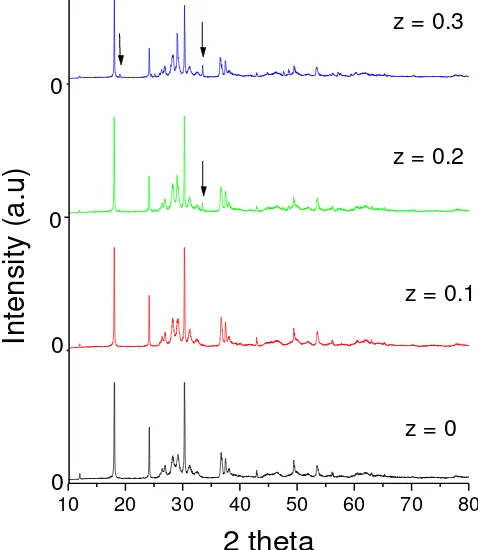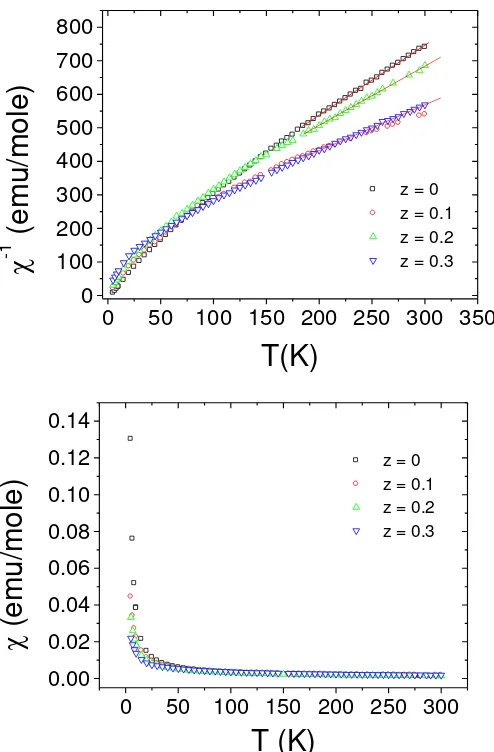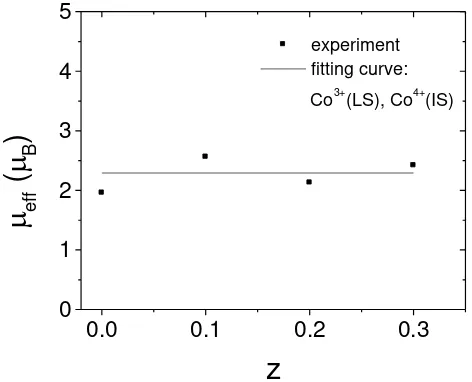Received November 28th, 2011, Revised May 8th, 2012, Accepted for publication August 3rd, 2012. Copyright © 2012 Published by LPPM ITB, ISSN: 1978-3043, DOI: 10.5614/itbj.sci.2012.44.3.3
Magnetic States of the Co-ions in Ca and Y Doped
(Bi,Pb)
2Sr
2Co
2O
8Thermoelectric Materials
Inge M. Sutjahja & A. Agung Nugroho
Physics of Magnetism and Photonic Research Division
Faculty of Mathematics and Natural Sciences, Institut Teknologi Bandung Jl. Ganesha No. 10, Bandung, Indonesia 40132
Email: [email protected]
Abstract. The magnetic states of Cobalt ions in magnetic thermoelectric materials of Bi1.5Pb0.5Ca2-zYzCo2O8 (z = 0, 0.1, 0.2, and 0.3) have been studied from the structural (X-ray diffraction) and magnetic susceptibility data. The misfit structure was revealed from refinement of the XRD data, with reduction of the lattice parameters while increasing the Y doping content. Compared with the (Bi,Pb)2Sr2Co2O8 parent compound system, the lattice parameter c was reduced significantly, while the misfit degree remained almost the same. The analysis of the magnetic data shows that the Cobalt ions are coupled antiferromagnetically within the CoO2 layers, with the existence of mixed valence states between Co3+ and Co4+ ions. Besides that, the effective magnetic moments of Cobalt ions are almost constant along the Y doping content. Assuming the orbital quenching as commonly found in most transition metal ions, the data are best fitted by taking the low-spin state of Co3+ ions and intermediate spin state of Co4+ ions. We argue qualitatively, that the spin-state transition across the gap are induced by the shrinkage of the charge transfer energy gaps between O 2p and Co eg levels due to reduction of the ionic spaces between Co and O ions.
Keywords: antiferromagnetic; mixed valence states; spin state; thermoelectric materials.
1
Introduction
associated with different electron configuration of the d-orbitals, which are supposed to be largely responsible for the observed properties [3].
Following the discovery of a large thermoelectric power (100 V/K) at 300 K in NaCo2O4 [4], the Bi2Sr2Co2Ox compound [5] as well as its Pb doped species
[6,7] have become the object of considerable research interest. These compounds have been shown to offer potentially even larger thermoelectric power
S2
at about the same elevated temperature, due to the increased Seebeck coefficient (S) and the decrease of electric resistivity () with increasing temperatures [5-7]. The hole doping induced by the partial substitution of the trivalent Bi3+ by the divalent Pb2+ is supposed to be related to the further enhancement of the thermoelectric performance of the doped compound. These compounds have also been found to feature a misfit-layer structure and the Co3+Co4+ mixed-valence states [8]. Subsequently, the thermalconductivity () measurement of the Pb-doped compounds was performed, both
for the in-plane [9] and out-of-plane [10] directions, showing significantly lower for the latter due to the strong phonon scattering by the lattice misfit. In the mean time an X-ray absorption study of the (Bi,Pb)-Sr-Co-O compounds further indicated the presence of Co3+Co4+ mixed-valence states with t26g and
5 2g
t low-spin configurations, respectively [11], in agreement with the very small
magnetic moment of about 0.1B [12].
In subsequent efforts to further explore new thermoelectric materials, both (Bi,Pb)-Sr-Co-O and (Bi,Pb)-Ca-Co-O compounds with additional doping of trivalent Y, and other trivalent elements (Sc,La), were reported to exhibit favorable temperature dependent electric transport behaviors [13,14]. However, no explicit information was offered on the spin state of Co3+ and Co4+. In this experiment we focused on the Y-doped (Bi,Pb)-Ca-Co-O compound and the analysis of the Co ions spin states on the basis of the magnetization data.
2
Experiment
The magnetic thermoelectric materials of Bi1.5Pb0.5Ca2-zYzCo2O8 (z = 0, 0.1, 0.2,
and 0.3) have been prepared from precursors of Bi2O3, PbO, SrCO3, CaCO3,
Y2O3 and Co3O4 by a conventional solid-state reaction method. The precursors
susceptibility measurements were performed using PPMS in the ZFC mode with an applied field of 1000 Oe in a temperature range between 5 and 300 K.
3
Results and Analysis
The results of the XRD measurement of the Bi1.5Pb0.5Ca2-zYzCo2O8
polycrystalline samples with z = 0, 0.1, 0.2 and 0.3 are shown in Figure 1. Structural analysis or refinement of the XRD data was performed using the Rietica 2007 program. Assuming the misfit structure like in the case of the undoped Bi2Sr2Co2O8 parent compound [15], the data were fitted using a
monoclinic structure with space groupC2/C and two-phase parameters for the rocksalt and CoO2 sublattices. The results show that the misfit character of the
structure was revealed by the difference between the lattice parameters b1 and b2
that belong to the two sublattices. We found that with an increasing z value some additional peaks occur that cannot be refined, which might be due to some impurity phases.
10 20 30 40 50 60 70 80 z = 0
In
te
n
s
ity
(a
.u
)
2 theta
z = 0.1 z = 0.2 z = 0.3
0 0
0
0
Table 1 shows the evolution of lattice parameters a, b1, b2, c, and the angle
with respect to z. We note that except for the z = 0.3 samples, which contain some impurity phases, the lattice parameters a, b1, b2, and c tend to decrease
with an increasing z value, in agreement with the smaller ionic radii of the Y3+ ion compared to the Ca2+ ion. One can remark that the angle has increased with increasing Y content, while the value of b2/b1 that measures the degree of
the misfit structure is approximately equal to 0.537.
Table 1 The variations of lattice constants with Y concentration (z). z a (Å) b1 (Å) c (Å) b2 (Å) (deg) b2/b1
0 5.1267 5.217 29.498 2.8006 92.8186 0.537 0.1 5.1217 5.2161 29.4522 2.7975 92.8246 0.537 0.2 5.1202 5.2062 29.4310 2.7971 92.8703 0.537 0.3 5.1398 5.2436 29.5260 2.8024 92.829 0.534
The magnetic susceptibility versus temperature curves of the Bi1.5Pb0.5Ca
2-zYzCo2O8 (z = 0, 0.1, 0.2, and 0.3) samples are presented in Figure 2(a).
Apparently no sign of magnetic transition is observed in the temperature range
down to about 5 K. We note that the nonmonotonous value of with Y doping
is clearly visible in this figure. The associated 1T curves are presented in Figure 1(b). It is seen that the high temperature part (T > 200 K) of the data that show straight lines, obeys the Curie-Weiss law
C T
1 (1)
where is the molar magnetic susceptibility, C the Curie constant, and the Weiss temperature. Finally, the effective magnetic moment per Co ion, eff ,
can be obtained from the Curie constant, extracted from the 1T curve as given by
Beff
kC
N
C
12 128
3
(2)where kis Boltzmann’s constant (1.38 1016 erg/K), Nis Avogadro’s number,
0 50 100 150 200 250 300 350
From analysis of the data using Eqs.(1) and (2) we found that both the values of
C and eff vary nonmonoutonously with z. Indeed, the negative values of the
Weiss constant give the sign for the antiferromagnetic interaction of the Co ions in the CoO2 plane. The plot of eff versus z, as depicted in Figure 3, shows
similar samples, although they didn’t reported the exact value. Despite of this fact, we note also that in general the resulted effective magnetic moment values are smaller than the effective moment of the free ions, namely 6,70
B for Co3+ octahedral electrostatic field of oxygen ions with symmetry Oh. In addition, the competition between the repulsive interaction energy of electrons U (Hund’srule coupling) and the crystal field splitting
10Dq
will determine the population distribution of the 3d electrons in the t2g and eg orbitals. Hence, three different spin-states are denoted, low-spin (LS), intermediate-spin (IS), and high-spin (HS), according to the resulted total spin value (S). For instance, Co3+ ions with a 3d6 configuration can in principle exist in low-spin state (LS:6
Subsequently, we fitted the experimental data of the effective magnetic moment with the theoretical values, assuming the different spin-state configurations of the Co3+ and Co4+ ions. Hence the theoretical eff can be calculated according shown as a solid line in Figure 3, we found that the experimental result is best fitted by assuming the LS spin state of the Co3+ ions and the IS spin state of the Co4+ ions.
At this point, it is important to compare our results with those of the (Bi,Pb)2Sr2Co2Oy parent compound system in order to investigate the doping
effect [18]. From a structural point of view, the effect of Ca and Y doping leads to a significant reduction of lattice parameter c in the present system, due to the smaller ionic radii of the Ca2+ ions compared to the Sr2+ ions, although the misfit degree almost keeps the same value. The magnetic spin states of the Co3+ and Co4+ ions in the parent compound system are both low-spin, as deduced from the magnetic data [18] and X-ray absorption spectroscopy (XAS) measurement results [11]. Based on the correlation study, we argue qualitatively that in the Ca and Y doped (Bi,Pb)2Sr2Co2Oy thermoelectric materials the
decrease in lattice parameter c leads to a reduction of the ionic spaces between the Co and O ions, and leads to a shrinkage of the charge transfer energy gaps between the O 2p and Co eg levels. This phenomenon can induce the spin-state
shown by the reduction of the lattice parameters along the doping. The effective magnetic moment value of the Co-ions is almost constant toward the doping content and they are much smaller than the free ion values. Further analysis on the basis of the crystal field and the effect of quenching the orbital moment shows that the Co-ions persist in mixed valence states and different spin states, namely Co3+ in the low-spin state and Co4+ in the intermediate-spin state.
Acknowledgements
This work is supported by the Indonesia Toray Science Foundation (ITSF) Research Grant 2008 and Riset and Inovasi ITB 2011 under contract No. 223/I.1.C01/PL/2011. The XRD data were taken in Japan. The magnetic susceptibility measurements were performed in Cologne, Germany.
References
[1] Tokura, Y. & Nagaosa, N., Orbital Physics in Transition-Metal Oxides, Science, 288, p. 462, 2000.
[2] Orenstein, J. & Millis, A.J., Advances in the Physics of High Temperature Superconductivity, Science, 288, p. 468, 2000.
[3] Gerloch, M. & Constable, E.C., Transition Metal Chemistry, published by VCH Verlagsgesellschaft, Weinheim (Germany) & VCH Publishers, New York (USA), 1994.
[4] Terasaki, I., Sasago, Y. & Uchinokura, K., Large Thermoelectric Power in NaCo2O4 Single Crystals, Phys. Rev. B, 56, pp. R12685-R12687,
1997.
[5] Funahashi, R. & Shikano, M., Bi2Sr2Co2Oy Whiskers with High
Thermoelectric Figure of Merit, Appl. Phys. Lett., 81, pp. 1459-1461, 2002.
[6] Itoh, T. & Terasaki, I., Thermoelectric Properties of Bi2.3-xPbxSr2.6Co2Oy
Single Crystals, Jpn. J. Appl. Phys., 39, pp. 6658-6660, 2000.
[7] Xu, G., Funahashi, R., Shikano, M., Matsubara, I. & Zhou, Y.,
Thermoelectric Properties of Bi2.2−xPbxSr2Co2Oy System, J. Appl. Phys.,
91, p. 4344, 2002.
[8] Yamamoto, T., Tsukada, I., Uchinokura, K., Takagi, M., Tsubone, T., Ichihara, M. & Kobayashi, K., Structural Phase Transition and Metallic Behavior in Misfit Layered (Bi,Pb)-Sr-Co-O System, Jpn. J. Appl. Phys.,
39, pp. L747-750, 2000.
[9] Satake, A., Tanaka, H., Ohkawa, T., Fujii, T. & Terasaki, I., Thermal Conductivity of the Thermoelectric Layered Cobalt Oxides Measured by the Harman Method, J. Appl. Phys., 96, p. 931, 2004.
[11] Mizokawa, T., Tjeng, L.H., Steeneken, P.G., Brookes, N.B., Tsukada, I.,
Yamamoto, T. & Uchinokura, K., Photoemission And X-Ray-Absorption
Study of Misfit-Layered (Bi,Pb)-Sr-Co-O Compounds: Electronic Structure of A Hole-Doped Co-O Triangular Lattice, Phys. Rev. B, 64, pp. 115104-1 – 115104-7, 2001.
[12] Tsukada, I., Yamamoto, T., Takagi, M., Tsubone, T., Konno, S. &
Uchinokura, K., Ferromagnetism and Large Negative Magnetoresistance
in Pb Doped Bi–Sr–Co–O Misfit-Layer Compound, J. Phys. Soc. Japan,
70, p. 834, 2001.
[13] Iguchi, E., Katoh, S., Nakatsugawa, H. & Munakata, F., Thermoelectric Properties (Resistivity and Thermopower) in (Bi1.5Pb0.5Ca2-xMxCo2O8- (M
= Sc3+, Y3+, or La3+), J. of Solid State Chemistry, 167, pp. 472-479, 2002. [14] Iguchi, E., Itoga, T., Nakatsugawa, H., Munakata, F. & Furuya, K.,
Thermoelectric Properties in Bi2-xPbxSr3-yYyCo2O9-, J. Phys. D: Appl.
Phys., 34, pp. 1017-1024, 2001.
[15] Leligny, H., Grebille, D., Perez, O., Masset, A.C., Hervieu, M. & Raveau, B., A Five-Dimensional Structural Investigation of The Misfit Layer Compound [Bi0.87SrO2]2[CoO2]1.82, Acta Crystallographica Section B,
B56, pp. 173-182, 1999.
[16] Craik, Derek, Magnetism (Principles and Applications), John Wiley & Sons, 1995.
[17] Xu, X., Jiang, L., Shen, J., Chen, Z., Xu, Z., Relationship between spin state of Co ions and thermopower in La1-xSrxCoO3(0≤x≤0.5), Phys. Lett.
A, 351, pp. 431-434, 2006.
[18] Sutjahja, I.M., The Change in Physical Properties of Bi2Sr2Co2O8



